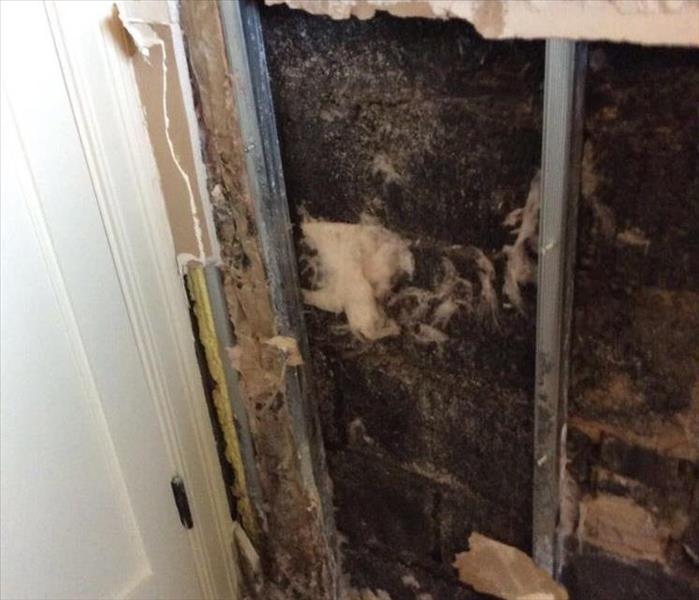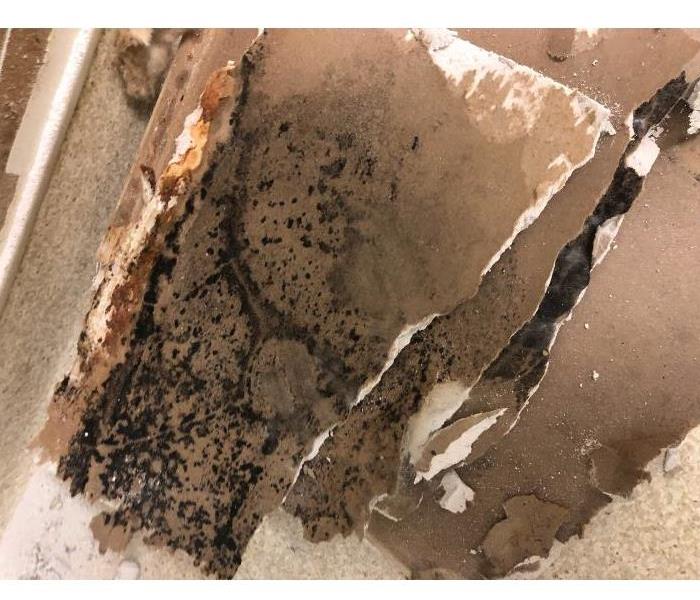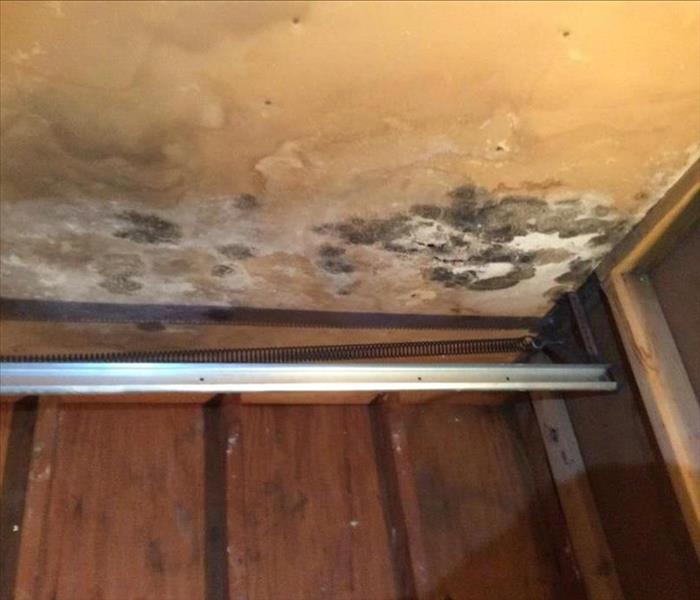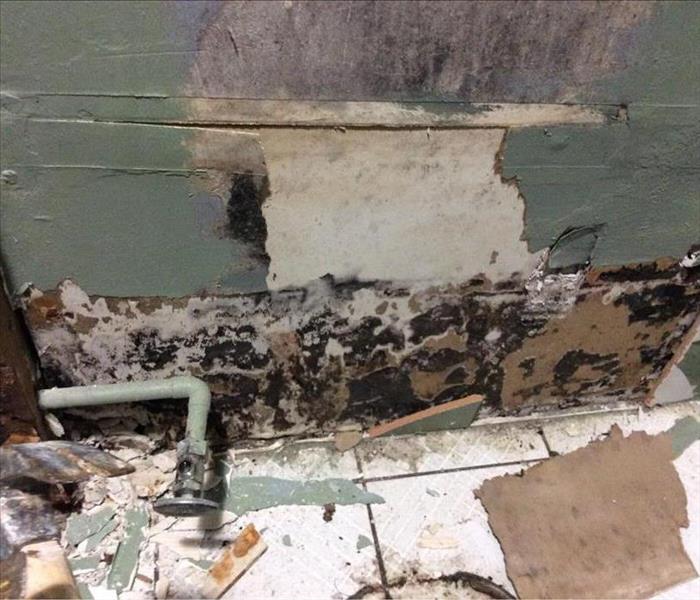Recent Mold Remediation Posts
The Challenge with Mold Sampling
5/27/2022 (Permalink)
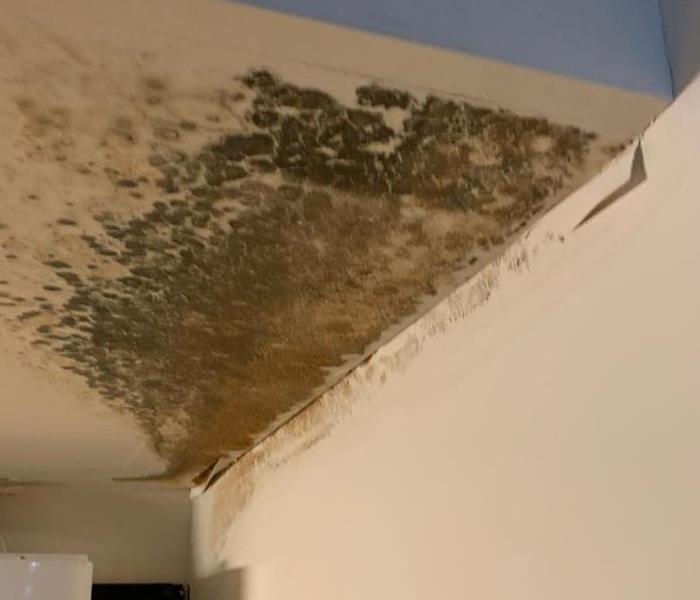 Noticeable mold growth in the home.
Noticeable mold growth in the home.
The Challenge with Mold Testing or Sampling
Is sampling for mold needed?
In most cases, if visible mold growth is present, sampling is unnecessary. Since no EPA or other federal limits have been set for mold or mold spores, sampling cannot be used to check a building's compliance with federal mold standards. Surface sampling may be useful to determine if an area has been adequately cleaned or remediated. Sampling for mold should be conducted by professionals who have specific experience in designing mold sampling protocols, sampling methods, and interpreting results. Sample analysis should follow analytical methods recommended by the American Industrial Hygiene Association (AIHA), the American Conference of Governmental Industrial Hygienists (ACGIH), or other professional organizations.
Are there federal regulations or standards regarding mold testing?
Standards or Threshold Limit Values (TLVs) for airborne concentrations of mold, or mold spores, have not been set. Currently, there are no EPA regulations or standards for airborne mold contaminants.
Please note that SERVPRO does not conduct mold testing. We are specialists in the remediation of mold and believe that separating mold detection and its remediation eliminates any potential conflict of interest. Call us today for a free consultation.
Mold is Everywhere
5/27/2021 (Permalink)
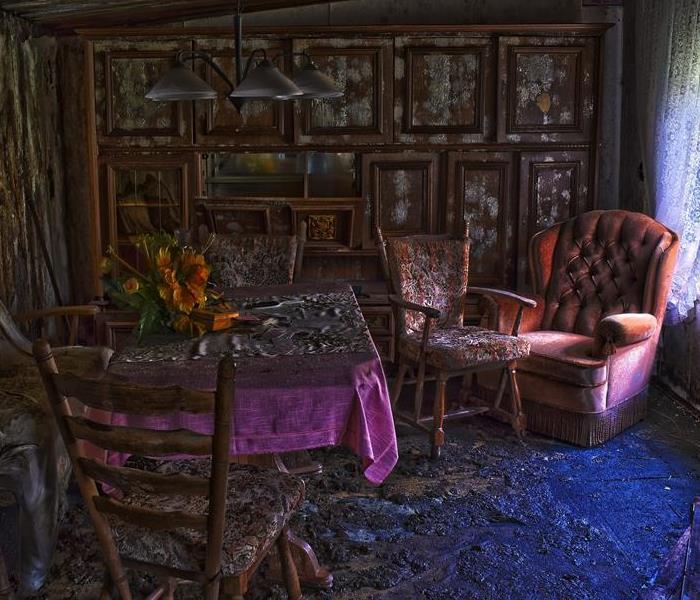 Living room covered in mold.
Living room covered in mold.
Did you know that mold is everywhere, both outside and inside your home? The spores are constantly floating around and cause little adverse issues until they find a nice moist place to grow. This is where small leaks in roofs, pipes, basements, windows, etc. can create a serious problem for both health and property.
Places where mold often appears include:
- areas where leaks occur, especially behind walls and concealed by sheetrock
- where flooding has occurred
- areas that routinely get wet (where is your dog's bowl?)
- windows where condensation builds up
- places where the air does not circulate well
- wet cellulose materials are most supportive of mold growth.
Molds produce spores, which spread by floating in the air. Mold spores are present in all indoor environments. There is no way to prevent spores, and they can persist in conditions where mold itself cannot grow.
Mold spores thrive in environments that are moist and warm, so when they land on a damp spot, they begin to grow.
Molds can grow on a variety of different surfaces, including fabric, paper, wood, glass, and plastic. As they grow, they may digest the material they are growing on.
Molds are classified in three different ways:
Allergenic: Molds that cause and produce health effects.
Pathogenic: Molds that cause health effects in those suffering from an acute illness.
Toxigenic: Molds that produce toxic substances that can lead to health effects. This is sometimes referred to as “toxic mold.”
PROFESSIONAL MOLD REMOVAL
Getting rid of mold is a very complex undertaking. Not only is mold difficult to identify, but it’s also dangerous to be around. SERVPRO uses mold remediation equipment and techniques that protect both you and our team. Our remediation strategy is specifically designed to address the damage that has already occurred and prevent the problem from recurring.
Not sure if there is an issue?:
SERVPRO intentionally does not do mold testing to prevent any potential conflict of interest. Often times the mold is obvious to our technicians. If there is uncertainty, we can recommend a reputable testing company that can help. Based on their findings we will develop a plan to address the remediation.
Call us today for more information.
How to Prevent Mold in the First Place
2/6/2019 (Permalink)
Here are a handful of easy tips to help prevent mold from growing:
- Keep humidity levels below 50% at all times.
- Rooms that get damp, like bathrooms and kitchens, should have ventilation, including an exhaust system, to keep humidity down. Also, don’t use carpeting in these areas.
- Make sure to clean bathrooms and kitchens with cleaning products that kill of mold.
- During humid weather, make sure to use an air conditioner or dehumidifier.
- Consider using mold inhibitors that be added to paints.
According to the Center for Disease Control, you should not attempt to clean-up mold that is more than 10 square feet in size.
If your mold problem is small, in many cases it can be cleaned from hard, non-porous surfaces using soap and water or a mixture of one cup bleach to one cup water. Make sure to open doors and windows to provide air ventilation and be sure to wear protective gloves and eyewear.
Note: it is important to both clean and dry the area thoroughly as allergic reactions to dead mold are possible, and you want to make sure to remove the entire source of the moisture.
If mold is problem or if you have any questions or doubts, your best bet is to call a professional like SERVPRO of Hackensack/Little Ferry. We can start the remediation process as soon as you contact us, and our specially trained mold damaged specialists can quickly get your home or business back to normal with the training and expertise required to effectively handle your restoration needs.
Telltale Signs of of Mold and Where to Look for Them
1/31/2019 (Permalink)
Mold growth depends on certain conditions for growth such as poor ventilation, moisture and air temperature. Every home has areas that have the potential for mold growth, so it is important to know where to look and what to look for.
Look for:
- Discoloration on walls, carpets and floors
- Visible mild growth – black, white, red, orange, yellow, blue, violet, etc.
- Noticeable muster and/or dirt odor
Places to inspect for mold growth:
- Under and behind sinks and vanities
- Behind washing equipment
- Under and behind refrigeration units
- Under dishwashers
- Behind toilets
- Behind and below water heaters
- Around tubs and showers
- Around doors and windows
- Around basement perimeters
- In crawl spaces
- Above ceiling tiles
- Around the outside hose bib
- Inside access panels to whirlpool tubs
If you DO find any mold in your home, it is always best to call a professional to take care and remediate the issue. Mold spores are easily dispersed if incorrectly disturbed and most household cleaners won’t sufficiently take care of the problem.
SERVPRO of Hackensack/Little Ferry is always available to help home and business owners take care of water, mold and fire disasters quickly and thoroughly.
4 Mold Myths that Too Many People Believe Are True
1/21/2019 (Permalink)
Many people think they know everything they need to know about mold. It is true that mold can be a serious problem. But with the right information and a little common sense, you can learn to separate the myths and make smart decisions about any mold in your home.
Here are 4 mold myths that simply aren’t true:
Myth 1.) “All Mold is Dangerous and Unhealthy”
In fact, some kinds of mold make human life better. Just think of the life saving benefits of penicillin or the delicious taste of bleu cheese on a salad. These all come from mold.
While it’s true that some molds do cause health problems, the effects of mold on people can vary dramatically from person to person. Some molds produce allergens that can make life miserable for people sensitive to this allergy, and people with compromised immune systems are also often at greater risk to become sick from repeated mold exposure.
Myth 2.) “Bleach Kills All Mold Growth”
Many people when they discover mold in their homes immediately reach for the bleach and assume this will solve the problem. Unfortunately, this is not always the case.
Bleach may kill certain kinds of mold growth, especially on non-porous surfaces. But bleach has not been proven to be effective on all kinds of mold, and it frequently doesn’t work so well on porous materials such as wood.
In addition, the amount of bleach that may be needed to clean-up a mold problem may in turn pose its own health risks.
Myth 3.) “If There’s Just a Little Mold, You Don’t Have to Worry”
Many people believe that if they see jut a little mold, they don’t have to worry about it. Unfortunately, sometimes a little mold is a big problem.
While it is true that mild mold growth may not cause any problems, what you see may not in fact be merely mild growth. Mold can be like an iceberg where what is visible is only the tip of major growth lurking beneath the surface.
Often times, the first visible signs of mold are just a signal that you have a major mold issue that needs to be remedied.
Myth 4.) “You Can Clean-Up Mold Yourself with Home Remedies”
According to the EPA, if your mold problem is “less than about 10 square feet (less than roughly a 3 ft. by 3 ft. patch), in most cases, you can handle the job yourself.” However, as was just discussed, many times the mold you see is just the surface of a larger underlying problem.
If you even suspect that your mold problem may be larger than 10 square feet, or you’ve been experiencing health symptoms that may be related to mold exposure, you should bring in a professional mold remediation service provider as soon as you can.
SERVPRO of Hackensack/Little Ferry has the training and equipment necessary to thoroughly inspect and address any mold issues you may encounter. We’ve helped many homes and businesses in the community with mold problems both large and small, including providing 24/7 emergency services.
Tips on How to Stop Mold
1/2/2019 (Permalink)
ips on How to Stop Mold Before it Starts
Mold can be a problem in your home, even before it becomes a visible issue. Mold can cause serious health problems and even ruin parts of your home. Mold likes to grow in dark and damp environments, so sometimes you'll notice a damp, moldy smell in the air long before you ever see signs of a mold problem. Here are three tips to stop it before it even gets started.
Temperature Matters
Mold festers in warm temperatures, from around 70-degrees Fahrenheit and above. Warmer weather can instigate mold growth. Areas in your home that are allowed to surpass the 80-degree mark are the most susceptible. If you do not have central air conditioning, consider installing a couple window units, especially in those rooms of your home that can become damp, like bathrooms and kitchens.
In the winter, check places where condensation collects, such as windows and doors. The heat from your home reacting to the cold outside will create moisture, especially if the area is not well insulated. If you have an older home, consider adding weather strips around drafty openings.
Air Circulation
Mold will thrive in environments where there is little or no air movement. Even if the temperatures are cooler, stagnant air allows mold to generate enough heat itself that it spreads. Once mold gets a foothold, it can be difficult to stop.
Vent fans are excellent additions to bathrooms, or other places in your home where air can become stagnate. When warmer temperatures occur, ceiling fans are excellent ways to keep air circulating. A couple strategically placed floor fans can also help curb the ability of mold to grow.
Moisture
The last problem you need to be concerned about is probably the most important. Mold needs moisture to grow. Without moisture in some form, mold will dry up and turn to dust.
Leaks & Drips
Leaky faucets and dripping drains are some common problems, but they are easily spotted and usually a simple fix. The biggest problem with mold and moisture can the damp areas that you cannot see, or are not aware of. Always fix water leaks and drips immediately though.
Gutters & Eaves
Gutters that are not well maintained can become clogged. When this happens rainwater can drip back under the eaves on your home and begin to slowly seep behind your exterior walls, where mold can grow unnoticed.
A Clean Sweep
Dirt can also attract moisture as well as be a food source for mold. Vacuum at least once a week. If you have pets that shed, it would be well advised to vacuum a little more frequently.
Mold can become an expensive problem once it takes hold. Be attentive to moisture, circulate the air in your home whenever possible, and keep it clean.
Controlling Moisture Deters Mold Growth
11/8/2018 (Permalink)
Beware of moisture in your home! It not only comes from the obvious like water leaks, showers or cooking, but from temperature differences between outside and inside your home (as seen as condensation on your windows) leaking air conditioners, humidifiers or improperly vented combustion appliances and clothes dryers.
Any level of moisture can become the perfect habitat for mold growth.
So how do you begin to control moisture in your home? According to the EPA, the following steps can be taken to keep moisture – and subsequently mold – at bay:
Fix leaks and seepage. If water is entering the house from the outside, your options range from simple landscaping to extensive excavation and waterproofing.
Place a plastic cover over dirt in crawlspaces to prevent moisture from coming in from the ground. Be sure crawlspaces are well ventilated.
Use exhaust fans in bathrooms and kitchens. Make sure fans are vented to the outside, and not the attic.
Turn off certain appliances (such as humidifiers or kerosene heaters) if you notice moisture on windows and other surfaces.
Use dehumidifiers and air conditioners, especially in hot, humid climates.
Raise the temperature of cold surfaces where moisture condenses. Insulate storm windows and open doors between rooms to circulate warm air. Using fans and moving furniture away from wall corners can help increase air circulation.
Be careful of carpet on concrete floors. Carpet can absorb moisture and serve as a place for biological pollutants to grow. Use area rugs which can be taken up and washed often. In some climates it may be necessary to use a vapor barrier over the concrete.
While these tips may help control moisture in your home, it may not guarantee the complete prevention of mold growth. If you do suspect mold, have your home tested, and make sure to call SERVPRO of Hackensack/Little Ferry to remediation your home safely and properly.
Does Your Home or Business Have A Mold Problem?
1/18/2017 (Permalink)
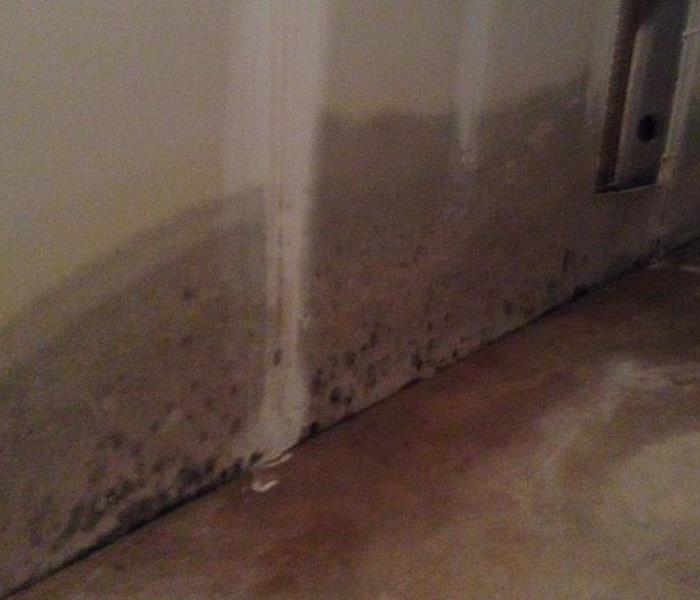 Mold can spread throughout a home in as little as 48 hours!
Mold can spread throughout a home in as little as 48 hours!
Microscopic mold spores naturally occur almost everywhere, both outdoors and indoors. This makes it impossible to remove all mold from a home or business. Therefore, mold remediation reduces the mold spore count back to its natural or baseline level. Some restoration businesses advertise “mold removal” and even guarantee to remove all mold, which is a fallacy. Consider the following mold facts:
- Mold is present almost everywhere, indoors and outdoors.
- Mold spores are microscopic and float along in the air and may enter your home through windows, doors, or AC/heating systems or even hitch a ride indoors on your clothing or a pet.
- Mold spores thrive on moisture. Mold spores can quickly grow into colonies when exposed to water. These colonies may produce allergens and irritants.
- Before mold remediation can begin, any sources of water or moisture must be addressed. Otherwise, the mold may return.
- Mold often produces a strong, musty odor and can lead you to possible mold problem areas.
- Even higher-than-normal indoor humidity can support mold growth. Keep indoor humidity below 45 percent.
If your home or business has a mold problem, we can inspect and assess your property and use our specialized training, equipment, and expertise to remediate your mold infestation.
If You See Signs of Mold, Call Us Today – SERVPRO of Hackensack/Little Ferry (201) 742-5920





 24/7 Emergency Service
24/7 Emergency Service


